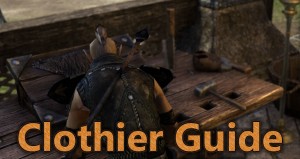 Clothier is one of the six professions your character has in The Elder Scrolls Online. Clothiers are specialized in creating Light and Medium armor using cloth and hides from creatures. Much like other crafting skills, the equipment you can make with Clothier are comparable to some of the best items you can get in the game, and certain set bonuses can only be applied by proficient crafters.
Clothier is one of the six professions your character has in The Elder Scrolls Online. Clothiers are specialized in creating Light and Medium armor using cloth and hides from creatures. Much like other crafting skills, the equipment you can make with Clothier are comparable to some of the best items you can get in the game, and certain set bonuses can only be applied by proficient crafters.
This guide will give you a basic rundown of everything relating to Clothier profession, so if you’re interested in it be sure to read it.
Contents:
Clothier Basics
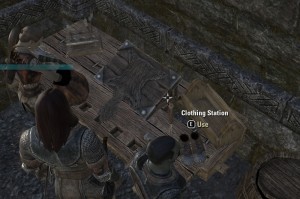 Clothiers can craft Light and Medium armor by using cloth and leather found on monsters throughout the world, or by picking up materials from resource nodes. To craft items you will need the necessary raw materials, and like other professions interact with an appropriate crafting station in the world.
Clothiers can craft Light and Medium armor by using cloth and leather found on monsters throughout the world, or by picking up materials from resource nodes. To craft items you will need the necessary raw materials, and like other professions interact with an appropriate crafting station in the world.
Clothiers can also make items with different racial styles and traits, all of which will be explained in this guide. You can also improve existing item’s quality by using Tannins, and deconstruct them to gain more Inspiration Points and resources.
Materials
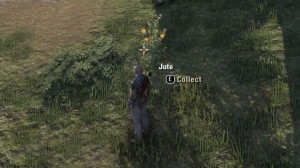 Two main resource types you will be using are Cloth and Leather. The first two, Raw Jute and Hide Scraps can be used by any character and don’t require any proficiency in Clothier professions, but other materials will require investing into the skill tree to be used.
Two main resource types you will be using are Cloth and Leather. The first two, Raw Jute and Hide Scraps can be used by any character and don’t require any proficiency in Clothier professions, but other materials will require investing into the skill tree to be used.
The table below will provide you with a list of raw and refined materials, as well as approximate levels of items crafted using these resources:
| Level: | Raw Cloth: | Refined: | Raw Leather: | Refined: |
|---|---|---|---|---|
| 1-14 | Raw Jute | Jute | Hide Scraps | Hide |
| 16-24 | Raw Flax | Flax | Leather Scraps | Leather |
| 26-34 | Raw Cotton | Cotton | Thick Leather Scraps | Thick Leather |
| 36-44 | Raw Spidersilk | Spidersilk | Leather | Hide |
| 46-50 | Raw Ebonthread | Ebonthread | Topgrain Hide Scraps | Topgrain Hide |
| 50 | Raw Famin | Famin | Fell Hide Scraps | Fell Hide |
| 50 | Ironweed | Ironthread | Iron Hide Scraps | Iron Hide |
| 50 | Saint’s Hair | Silverweave | Scaled Hide Scraps | Scaled Hide |
| 50 | Void Bloom | Void Cloth | Daedra Hide Scraps | Daedra Hide |
In order to be able to use raw materials you first need to refine them. It’s done by simply visiting any Clothier station in the world.
Clothing Skill Line
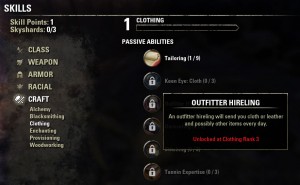 If you want to craft items past level 14, you will need to invest skill points in the Clothing skill line. Bare minimum you’ll need to spend in order to use all raw materials is 8 points, but there are other useful passives you can take as well.
If you want to craft items past level 14, you will need to invest skill points in the Clothing skill line. Bare minimum you’ll need to spend in order to use all raw materials is 8 points, but there are other useful passives you can take as well.
- Tailoring (8) – Allows the use of higher level cloth and leather.
- Keen Eye: Cloth (3) – Fibrous plants in the world will be easier to see when you’re 20-40 meters or closer.
- Outfitter Hireling (3) – An outfitter hireling will send you cloth or leather and possibly other items every day or twice a day.
- Unraveling (3) – Improves the chances of extracting Clothing ingredients.
- Stitching (3) – Reduces research times by 5%/10%/20% and enables you to research two or even three traits at the same time.
- Tannin Expertise (3) – Increases your chance to improve items with tempers tannins.
As mentioned spending 8 points in Tailoring is a must if you intend to do any endgame crafting. Keen Eye is very helpful for Clothiers as some raw materials can be hard to spot in the world. You can safely skip it if you don’t have trouble spotting Jute and other materials. Outfitter Hireling is best taken a early as you can: sometimes you can get very good items delivered straight to your mailbox for no effort, but it’s up to you to decide if it’s worth spending skill points in.
Unraveling can be greatly beneficial to Clothiers as you will be extracting materials from your items quite frequently. Stitching is perhaps the second most beneficial passive: to research all possible traits on all items would take over 2 years of real time, so reducing it even by 20% can mean a great deal of time saved (more about research times below). Finally, Tannin Expertise will help you improve items with less Tannins used; high quality tannins can be hard to come by and if you’re often improving the quality of your items this passive is not a bad choice.
Research
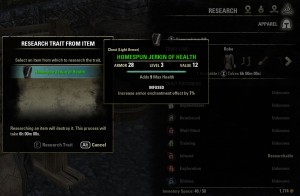 An important part of being a skilled tailor is access to multiple traits. To learn how to add traits to items, you will first need to research them by destroying existing items containing the trait you want. It means if you want to add for example Impenetrable (increased resistance to critical hits) trait to a certain chest piece, you will need to obtain an existing chest piece with Impenetrable trait from a quest, monster drop or from another player. Researching this trait on a chest piece however only enables you to add it to this item slot — you will not be able to add it on gloves or boots unless you destroy and research from those item slots as well.
An important part of being a skilled tailor is access to multiple traits. To learn how to add traits to items, you will first need to research them by destroying existing items containing the trait you want. It means if you want to add for example Impenetrable (increased resistance to critical hits) trait to a certain chest piece, you will need to obtain an existing chest piece with Impenetrable trait from a quest, monster drop or from another player. Researching this trait on a chest piece however only enables you to add it to this item slot — you will not be able to add it on gloves or boots unless you destroy and research from those item slots as well.
It’s also important to know that for every item slot you want to add the same trait to, research times will double each time. First research takes 6 hours, second 12 hours, etc., totaling to 64 days per item. 8 traits and 14 items means it would take nearly 900 days or real-life time to research everything. Spending skill points into Stitching to reduce research times and enable researching multiple traits concurrently suddenly seems more appealing, doesn’t it.
I do have a guide up talking specifically about traits and research so be sure to read it to familiarize yourself more with this system.
Extraction
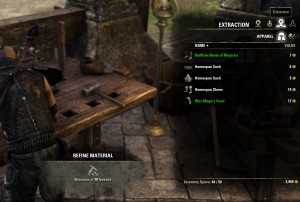 The Extraction tab in the crafting interface enables you to deconstruct existing items into base materials. Extraction will provide you with any raw materials used to create the item, but potentially also give you tannins, used to improve an existing item’s quality. Extraction interface is also used to refine raw materials.
The Extraction tab in the crafting interface enables you to deconstruct existing items into base materials. Extraction will provide you with any raw materials used to create the item, but potentially also give you tannins, used to improve an existing item’s quality. Extraction interface is also used to refine raw materials.
Since a majority of the items you will make will simply be crafted for the purposes of leveling your profession, extracting them for additional materials (and Inspiration) is a good way to get some of your investment back. Important to remember is that extracting items crafted by other players gives up to 800% more Inspiration than extracting items your crafted yourself!
Most equipment in The Elder Scrolls Online isn’t worth much selling to vendors, and more than often it’s best to use it for research or extraction.
Improvement
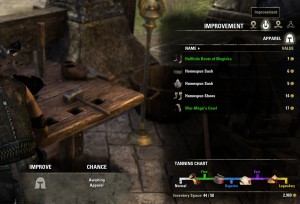 Improving existing items to a higher quality one is a great perk of crafters, Clothiers included. Items in the game have 5 quality levels: white (normal), green (fine), blue (superior), purple (epic) and gold (legendary). To improve an item you will need Tannins, most commonly gained by extracting items. Outfitter Hireling will often send you some as well, or alternatively you can purchase them from other players. When extracting for example blue items, you can only get Embroidery tannin which is used to upgrade green items into blue ones. This makes purple and gold tannins quite rare and expensive, as you would need to destroy several items of the respective quality to obtain them.
Improving existing items to a higher quality one is a great perk of crafters, Clothiers included. Items in the game have 5 quality levels: white (normal), green (fine), blue (superior), purple (epic) and gold (legendary). To improve an item you will need Tannins, most commonly gained by extracting items. Outfitter Hireling will often send you some as well, or alternatively you can purchase them from other players. When extracting for example blue items, you can only get Embroidery tannin which is used to upgrade green items into blue ones. This makes purple and gold tannins quite rare and expensive, as you would need to destroy several items of the respective quality to obtain them.

When improving items you can’t skip quality tiers, meaning you can NOT upgrade a green item directly into a purple one. Instead, you will first need to upgrade your green item to a blue one, then use additional tannins to upgrade to a purple. With five item quality levels there are also four different tannins:
- Hemming – improves quality from white to green
- Embroidery – improves item quality from green to blue
- Dreugh Wax – improves item quality from blue to purple
- Nord Lining – improve quality from purple to gold
Improving items can fail, in which case the item you attempted to improve will be permanently destroyed! By adding one tannin you have a 20% chance to improve an item’s quality, and you can increase this to 100% with five tannins, though it does get more expensive if you do. This does not account for passive skill Tannin Expertise which increases your base chance to improve items.
Racial Styles
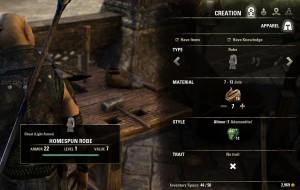 When creating items you’re given a choice of which item slot you want, how many materials to use and what traits you want your items to have. But you can also choose to create items in a particular racial style. The game currently includes 14 different racial motifs which change the appearance of items when worn.
When creating items you’re given a choice of which item slot you want, how many materials to use and what traits you want your items to have. But you can also choose to create items in a particular racial style. The game currently includes 14 different racial motifs which change the appearance of items when worn.
Your own racial style is automatically unlocked, basically meaning if you’re playing a Breton you are able to craft items in Breton style. Additional motifs are unlocked by finding (or purchasing from players) racial motif books, used to teach your character how to create items in that particular style. Once you learn an additional racial style it will be unlocked for all professions, not just Clothier.
Crafting in different racial styles also uses a specific racial style gemstone. These ingredients are frequently found in nightstands, cabinets and similar loot-able world objects, and you can also get them by deconstructing items crafted in a particular racial style.
Racial motifs don’t have any impact on an item’s functionality or stats, only its physical appearance. It’s not important to craft in any particular racial style, but there is a market for it and many players will look to purchase items with specific racial visual appearance.
Leveling
 Like every other crafting skill, Clothiers will also want to level up their profession as quick as possible. Experience in professions is indicated by Inspiration, which is essentially an experience bar (don’t confuse it with your own character’s experience bar; crafting items will not increase your character XP or levels).
Like every other crafting skill, Clothiers will also want to level up their profession as quick as possible. Experience in professions is indicated by Inspiration, which is essentially an experience bar (don’t confuse it with your own character’s experience bar; crafting items will not increase your character XP or levels).
Much like other craft skills, a good rule of thumb is to first create items you will actually use. Creating items however is not the most efficient gain of Inspiration Points (IP): deconstructing them gives more! Deconstructing quest rewards and monster drops will yield the highest amount of IP, so instead of selling everything to vendors for fairly small amounts of gold use it to level up your Clothier. When it comes to IP gains the item’s quality and level are the biggest factors determining the amount of IP you will gain, so extracting blue items will yield more IP than green items, and higher level items also yield more IP than lower level ones.
A trick that many Blacksmiths and Woodworkers also use to level their profession is also applicable for Clothiers: extracting items crafted by other players or your alts gives up to 800% more Inspiration than extracting the very same items you create yourself. Find a partner in crime and trade items you create with them and vice versa: you will powerlevel your profession significantly faster and with far less resources spent. If you join a player guild there’s bound to be at least one person interested in swapping items with you, so take advantage of it!
Lastly, since IP yield when deconstructing items is tied to item’s level it’s often wise to craft items which take the least amount of raw materials. Typically crafting level 4 or level 14 items is most efficient, but I’ll have more detailed calculations here shortly.
Closing
For everyone looking to create Medium and Light armor in TESO Clothing profession will provide more than enough options. Compared to Blacksmithing and Woodworking it’s quite likely the most efficient profession for selling large quantities of items to player and making gold, as these two armor types are the most frequently used ones. If you decide to become a proficient Clothier make sure you go all the way: spending points in Clothier skill line passives will have a good return on investment, and reducing research times as much as possible is extremely beneficial in the long run.
For a basic rundown of all professions and other crafting aspects and nuances be sure to read my crafting guide: if there’s anything that still confuses you, that guide should help explain it better.
Lastly, if you don’t mind spending a few bucks consider reading Killerguides, a professional strategy guide giving you further insight into not only Clothier and other tradeskills, but also pretty much every other aspect of the game you can think of.

guys with all the great games out there I cant keep people into the game with all this mant. we have been playing other games this is looking very bad what do u think can we stay in a game if all it does is mant. repair ? not so sure myself we don’t get rewarded as is leveling just has started driving folks away I cant keep people in my guild leveling just out right sucks I know if u spend money u lvl some what way too much money I know I spent my last dollar and I still don’t think eso vip is wroth 14 bucks a mo. anyway good luck c u on the downlow thekingjames